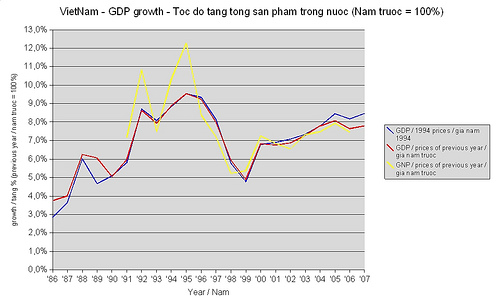Economy of Vietnam
After the devastation of the civil war, the people of Vietnam strove to rebuild their country with the aid of the former Soviet Union. Upon that stateís collapse in 1989, the Ministry of Industry and Trade embarked on new plans to sustain the economy of Vietnam. The government made improvements to infrastructure, education, and industry in the years following the loss of aid from the U.S.S.R. The Asian currency crisis was more of a wake-up call for the Vietnamese than a problem.(1) Corruption in the command economy was addressed and moves toward a free market system were allowed. Despite the devaluation of other south-east Asian currencies, Vietnamís GDP still grew at a healthy 6.7% during these years, allowing a fast recovery once the crisis was over.(2) Legislation over the last seven years has reaffirmed Vietnamís commitment to the free market system, and development and growth are estimated in the seven-to-eight percent range through 2012.
Labor in Vietnam offers a young, hardworking labor force that, due to the cultural emphasis on education and diligence, is literate and eager to learn the trades that foreign investors would bring to the country.(3) Higher levels of education are growing, but the natural willingness of the people to learn mean that the Vietnamese have faster rates of training to competency. Labor costs are very competitive, with the average salary of 824,000 VN Dong, or approximately 55 US Dollars. This has been shown to be a significant price break over wages in other south-east Asian countries, such as Malaysia and the Philippines.(4) Concerns about "sweatshop" labor have been addressed, and the labor code focuses on quality of life for workers. They are guaranteed an eight hour day and twelve days off for vacation, or up to 300% of their regular wage in compensation for overtime. In addition, to gain the most skilled workers, foreign companies pay considerably better than local industries, with correspondingly better conditions. Finally, the socialist framework, in conjunction with levies from companies, insures that all workers have access to healthcare.(5)Finally, with the acceptance of Vietnam into the WTO, the country has vowed to both comply with the rules governing that body and make further changes to increase the competitiveness of Vietnamese goods, services, and investments. Import/Export duties have been scheduled to be reduced over the next five years, with the exception of certain items subject to excise taxes, by a full fifth.(6) While the banking sector currently consists of four major state banks and a host of new private ones, the government is on a plan to privatize the state banks and permit both private, outside investment in them and the opening of fully-foreign-owned branches of commercial banks.(7) Telecommunications and the energy sector are both undergoing privatization in stages, to comply with the WTO.(8) Finally, to ensure a level market for both domestic and foreign investors, the government continues to draft and enact legislation to protect the rights of private concerns and further reduce corruption.
|
Economic Data GDP (purchasing power): $258.6 Billion (2006) Per Capita GDP: $3,100 (2006) Labor Force: 44.58 million (2006) Unemployment rate: 2% Inflation rate: 7.5% (2006) |
|

